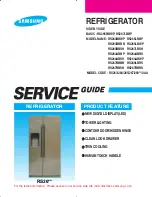
T-368
4–12
During setpoint pulldown supply air tempera-
ture is controlled according to the unit’s nomi-
nal supply air setpoint.
During CCPC pulldown the supply air tempera-
ture is lowered somewhat relative to the nomi-
nal setpoint. Evaporator fans are forced to
operate at high speed.
Steady
−
state CCPC control maintains the same lowered
supply air temperature as was used during CCPC pull-
down. The compressor cycles on and off according to
return air high and low limits. Depending on the fan mode
of operation selected, the evaporator fans may be pro-
grammed to run at low speed some or all of the time
according to the control logic.
4.6
CONTROLLER ALARMS
Alarm display is an independent controller software func-
tion. If an operating parameter is outside of expected
range or a component does not return the correct signals
back to the controller, an alarm is generated. A listing of
the alarms is provided in
The alarm philosophy balances the protection of the
refrigeration unit and that of the refrigerated cargo. The
action taken when an error is detected always considers
the survival of the cargo. Rechecks are made to confirm
that an error actually exists.
Some alarms requiring compressor shutdown have time
delays before and after to try to keep the compressor on
line. An example is alarm code “LO,” (low main voltage),
when a voltage drop of over 25% occurs, an indication is
given on the display, but the unit will continue to run.
An alarm is indicated by flashing an alarm code on the
display panel, and for some alarms, by the alarm light
illuminating.
When an Alarm Occurs:
a. The red alarm light will illuminate for “20 series”
alarms.
b. If a detectable problem is found to exist, its
alarm code will be alternately displayed with the
set point on the left display.
c. The user should scroll through the alarm list to
determine what alarms exist or have existed.
Alarms must be diagnosed and corrected before
the Alarm List can be cleared.
To Display Alarm Codes:
a. While in the Default Display mode, press the
ALARM LIST key. This accesses the Alarm List
Display Mode, which displays any alarms
archived in the Alarm Queue.
b. The alarm queue stores up to 16 alarms in the
sequence in which they occurred. The user may
scroll through the list by depressing an ARROW
key.
c. The left display will show “AL##,” where ## is
the alarm number sequentially in the queue.
d. The right display will show the actual alarm
code. “AA##” will display for an active alarm,
where “##” is the alarm code. Or “IA##” will dis-
play for an inactive alarm.
e. “END” is displayed to indicate the end of the
alarm list if any alarms are active.
f. “CLEAr” is displayed if all alarms are inactive.
The alarm queue may than be cleared by press-
ing the ENTER key. The alarm list will clear and
“-----” will be displayed.
NOTE
AL26 is active when all of the sensors are
not responding. Check the connector at the
back of the controller, if it is loose or
unplugged, reconnect it. Then run a pretrip
test (P5) to clear AL26.
4.7
PRE
−
TRIP DIAGNOSTICS
Pre-trip diagnostics is an independent controller function
that will suspend normal refrigeration controller activities
and provide preprogrammed test routines. The test rou-
tines include Auto Mode testing, which automatically per-
forms a pre
−
programmed sequence of tests or Manual
Mode testing, which allows the operator to select and run
any of the individual tests.
CAUTION
!
Pre-trip inspection should not be per-
formed with critical temperature cargoes
in the container.
CAUTION
!
When Pre-Trip key is pressed, dehumidi-
fication and bulb mode will be deacti-
vated. At the completion of Pre-Trip
activity, dehumidification and bulb mode
must be reactivated.
Downloaded from
Summary of Contents for 69NT40-541-505
Page 2: ...Downloaded from ManualsNet com search engine...
Page 4: ...Downloaded from ManualsNet com search engine...
Page 10: ...Downloaded from ManualsNet com search engine...
Page 14: ...Downloaded from ManualsNet com search engine...
Page 18: ...Downloaded from ManualsNet com search engine...
Page 80: ...Downloaded from ManualsNet com search engine...
Page 86: ...Downloaded from ManualsNet com search engine...
Page 92: ...Downloaded from ManualsNet com search engine...
Page 124: ...Downloaded from ManualsNet com search engine...
Page 125: ...Downloaded from ManualsNet com search engine...
Page 126: ...Downloaded from ManualsNet com search engine...
Page 142: ...Downloaded from ManualsNet com search engine...
















































